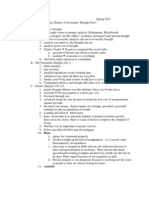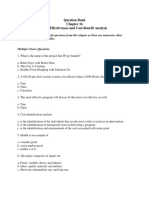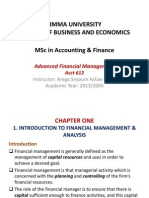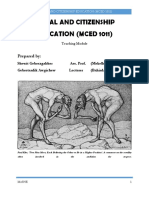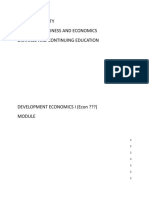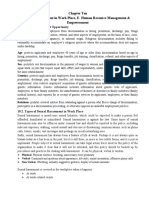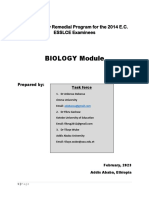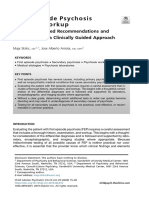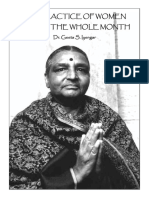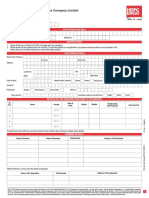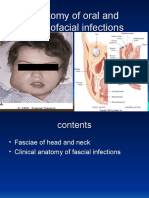Professional Documents
Culture Documents
BIO 101 Exit Exam Study Guide
BIO 101 Exit Exam Study Guide
Uploaded by
Olaide Seun AkintadeOriginal Description:
Copyright
Available Formats
Share this document
Did you find this document useful?
Is this content inappropriate?
Report this DocumentCopyright:
Available Formats
BIO 101 Exit Exam Study Guide
BIO 101 Exit Exam Study Guide
Uploaded by
Olaide Seun AkintadeCopyright:
Available Formats
BIO 101 Exit Exam BCCC
Study Guide
The BIO 101 Exit Exam is meant ONLY for Allied-health and Pre-nursing students attending Baltimore
City Community College. Students must pass with a 70% or better in order to be exempt from taking
either BIO 101 or BIO 102 as pre-requisites for other biology course requirements.
Any General Biology textbook may be used to prepare for this exam however the recommended text is:
Mader, Essentials of Biology 4th Edition, McGraw-Hill, ISBN ISBN-13: 978-0078024221
Topics include:
Animal Development Excretory System
Animal Reproduction General
Biotechnology Genetics
Body Orientation and Tissues Genomics
Cell Cycle and Mitosis Homeostasis
Cell Structure Inheritance
Cellular Respiration Levels of Biological Organization
Characteristics of Life Meiosis
Chemistry Metabolism
Circulatory System Molecular Biology
Digestive System Nervous System
DNA Replication Respiratory System
Endocrine System
Learning outcomes:
Describe the characteristics that all living organisms share.
Compare and contrast the three branches of life.
List and describe five elements of the scientific method.
List and give an example of five characteristics typical of living things.
Describe the principles of biology.
Relate how the arrangement of electrons determines an elements reactivity.
Contrast ionic and covalent bonds.
Identify the reactants and products in a chemical equation.
Distinguish between an acid and a base.
Interpret the pH scale.
Distinguish between organic and inorganic molecules
Summarize the categories of carbohydrates and provide examples of their diverse biological functions.
Summarize the categories of lipids and provide examples of their diverse biological functions.
Summarize the variety of protein types and provide examples of their diverse biological functions.
Explain why microscopes are needed to see most cells.
Summarize the relationship between the surface-area-to-volume ratio of a cell and its size.
Identify the characteristics common to all cells.
Distinguish between prokaryotic and eukaryotic cells.
State the components of the endomembrane system and list their functions.
Identify the energy roles that chloroplasts and mitochondria play in a cell.
Relate the specific components of the cytoskeleton to their diverse roles within the cell.
Summarize how the laws of thermodynamics and the concept of entropy relate to living organisms.
Describe the phases of the ATP cycle.
1 Prepared by Dr. K. Berlyn 06/2015
BIO 101 Exit Exam BCCC
Study Guide
Describe the flow of energy between photosynthesis and cellular respiration.
Identify the role that enzymes play in metabolic pathways.
Explain the induced fit model of enzymatic action.
Categorize the various ways in which materials can move across plasma membranes.
Explain osmosis and the effect it has on cells in various tonicity environments.
Define the various forms of bulk transport that can move materials into or out of a cell.
State the overall chemical equation for photosynthesis.
Recognize what is meant by the terms reduction and oxidation.
Define cellular respiration.
Identify the four phases of cellular respiration and identify the location of each within the cell.
Explain why fermentation pathways are beneficial when oxygen is not available.
Give examples of products made by fermenting yeast and bacteria.
Calculate the amount of ATP produced by each glucose molecule entering cellular respiration.
Summarize the purpose of cellular reproduction.
Summarize the activities that occur in the cell during interphase, mitosis, and cytokinesis.
Summarize the events in each phase of mitosis.
Describe the process of apoptosis.
Describe the characteristics of cancer cells.
Describe the factors that reduce the risk of cancer.
Explain the purpose of meiosis.
Define the terms diploid, haploid, sister chromatid, and homologous chromosomes.
Define nondisjunction and briefly explain how nondisjunction may bring about an abnormal
chromosome number.
Distinguish between genotype and phenotype.
Interpret a pedigree to determine if the pattern of inheritance is autosomal dominant or recessive.
Solve and interpret genetic crosses that exhibit incomplete dominance and codominance.
Describe the structure of a DNA molecule.
Compare and contrast the structure of RNA with that of DNA.
Explain what the genetic code is used for and explain why it is considered to be almost universal.
Differentiate between embryonic and adult stem cells.
Define the term transgenic.
Describe the primary characteristics of connective tissue.
Describe the function of nervous tissue.
Classify each organ system according to its involvement in transport, body maintenance, control,
sensory input and motor output, or reproduction.
List the general functions of each organ system.
Explain the importance of homeostasis.
Explain the role of the lymphatic system in circulation within the human body.
List the functions of blood.
Detail the types of blood cells and their functions.
List the components of the upper and lower respiratory tracts.
Explain how the urinary system participates in maintaining homeostasis.
2 Prepared by Dr. K. Berlyn 06/2015
BIO 101 Exit Exam BCCC
Study Guide
Identify the organs of the human digestive system and provide a function for each.
List the accessory organs of the digestive system and explain their functions.
Detail the digestion and absorption of specific nutrients (e.g., carbohydrates) in the digestive tract.
Describe the structure and function of a neuron.
Give examples of drugs of abuse and explain how they affect the nervous system.
Describe the structure and function of the central and peripheral nervous systems.
Identify the major endocrine glands of the body and summarize their role in the body.
Describe the structures of the male and female reproductive systems and their functions.
Explain how hormones regulate the male and female reproductive systems.
Evaluate the effectiveness of various means of birth control and explain how they work.
Describe the causative agents of common sexually transmitted diseases.
Describe the processes of fertilization, embryonic development, fetal development, and birth.
Describe the structure and function of the placenta.
3 Prepared by Dr. K. Berlyn 06/2015
You might also like
- The Gulf States and the Horn of Africa: Interests, influences and instabilityFrom EverandThe Gulf States and the Horn of Africa: Interests, influences and instabilityNoch keine Bewertungen
- History of Economic Thought Midterm - ReviewDocument7 pagesHistory of Economic Thought Midterm - ReviewUDeconNoch keine Bewertungen
- Demand and Supply in Health Care DemandsDocument1 pageDemand and Supply in Health Care DemandsAparna Kingini0% (1)
- Chapter FiveDocument8 pagesChapter FiveyimenueyassuNoch keine Bewertungen
- Awal ProposalDocument18 pagesAwal Proposalfajji100% (1)
- FPSC (Lectuer Economics)Document6 pagesFPSC (Lectuer Economics)ShAkeel AbbasiNoch keine Bewertungen
- Introduction To Development Planning WordDocument14 pagesIntroduction To Development Planning WordMuhdin Muhammedhussen100% (1)
- Critical Review of Epidemiologic StudiesDocument24 pagesCritical Review of Epidemiologic StudiesAmsaluNoch keine Bewertungen
- Ethiopia: Macroeconomic and Social Indicators IndicatorsDocument144 pagesEthiopia: Macroeconomic and Social Indicators IndicatorsAsmerom MosinehNoch keine Bewertungen
- Getachew ProposalDocument24 pagesGetachew Proposalibsituabdela100% (1)
- Chapter 16Document5 pagesChapter 16Pranay PandeyNoch keine Bewertungen
- Chapter One: Understanding International RelationsDocument8 pagesChapter One: Understanding International RelationsDAWIT DEJENENoch keine Bewertungen
- Global Trend: Chapter One Understanding International RelationsDocument178 pagesGlobal Trend: Chapter One Understanding International RelationsAdane BekeleNoch keine Bewertungen
- Carbon Stock and Woody Species Diversity in HomegardenDocument12 pagesCarbon Stock and Woody Species Diversity in HomegardenNuring SangkelatNoch keine Bewertungen
- Grade - 12 Civic & Ethical Education: Oromia Education Bureau in Collaboration WithDocument26 pagesGrade - 12 Civic & Ethical Education: Oromia Education Bureau in Collaboration WithÁbďùĺhäk Šhèïk Mūśťàfã100% (1)
- 1 Introduction To Biostatistics LastDocument19 pages1 Introduction To Biostatistics Lastdiriba debabaNoch keine Bewertungen
- Farming Systems and LIvelihoods Analysis ModuleDocument71 pagesFarming Systems and LIvelihoods Analysis ModuleRedi Sirbaro100% (1)
- Exam 3 NaRMDocument6 pagesExam 3 NaRMseidNoch keine Bewertungen
- Module 1 Unit 1 Lecture Notes Psych 111Document8 pagesModule 1 Unit 1 Lecture Notes Psych 111Hanny Castillo GulpoNoch keine Bewertungen
- Mid 1 CT Final Examination For First Year StudentsDocument4 pagesMid 1 CT Final Examination For First Year StudentshabtamuNoch keine Bewertungen
- FM - Chapter OneDocument63 pagesFM - Chapter Oneyosephworku100% (1)
- Things Are Intrinsically and Instrumentally Good or Bad? and Give Examples of Things Intrinsically and Instrumentally Good or Bad in Your SocietyDocument8 pagesThings Are Intrinsically and Instrumentally Good or Bad? and Give Examples of Things Intrinsically and Instrumentally Good or Bad in Your SocietyAbenezer SisayNoch keine Bewertungen
- University of . College of .. School/Department of . Syllabus For Economics (Common Course)Document7 pagesUniversity of . College of .. School/Department of . Syllabus For Economics (Common Course)Malasa EjaraNoch keine Bewertungen
- ,investment PPT SLU Chapters v-VI-1Document52 pages,investment PPT SLU Chapters v-VI-1Louat LouatNoch keine Bewertungen
- Chapter Two Human Development: By: Zelalem Wondimu School of Psychology Addis Ababa UniversityDocument44 pagesChapter Two Human Development: By: Zelalem Wondimu School of Psychology Addis Ababa UniversityAbel TayeNoch keine Bewertungen
- Agribusiness ManagementDocument6 pagesAgribusiness ManagementEYOB AHMEDNoch keine Bewertungen
- The Impact of Climate Change On Teff Production in Southeast Tigray, EthiopiaDocument8 pagesThe Impact of Climate Change On Teff Production in Southeast Tigray, EthiopiaPremier PublishersNoch keine Bewertungen
- Haramaya University Collage of Health and Medical Sciences School of Public Health MPH Entrance Exam/ 2020Document15 pagesHaramaya University Collage of Health and Medical Sciences School of Public Health MPH Entrance Exam/ 2020Mohammed AdusNoch keine Bewertungen
- IRD 200: State, Society and GovernmentDocument57 pagesIRD 200: State, Society and GovernmentJablack Angola Mugabe100% (2)
- Biology ExamDocument1 pageBiology ExamZemetu Gimjaw AlemuNoch keine Bewertungen
- Integrated Therapeutics IDocument74 pagesIntegrated Therapeutics IMelekNoch keine Bewertungen
- Wolde Proposal Final LockedDocument39 pagesWolde Proposal Final LockedKumsa SanbataNoch keine Bewertungen
- Econometrics Chapter Two-1Document41 pagesEconometrics Chapter Two-1haile ethioNoch keine Bewertungen
- Lecture 2Document112 pagesLecture 2Anusha Rose100% (1)
- Exam 2010 11Document4 pagesExam 2010 11koket negash100% (1)
- Unit 1 Choose The Best Answer From The Given AlternativesDocument6 pagesUnit 1 Choose The Best Answer From The Given AlternativesDesta LelagoNoch keine Bewertungen
- Exercise Chapter 1 and 2Document2 pagesExercise Chapter 1 and 2Emellda MANoch keine Bewertungen
- Growth & Diffferentiation in Tissue CultureDocument43 pagesGrowth & Diffferentiation in Tissue CulturelordniklausNoch keine Bewertungen
- Social Anthropology Chapter 3-7Document80 pagesSocial Anthropology Chapter 3-7Fnan YemaneNoch keine Bewertungen
- Lesson 1. Cell TheoryDocument1 pageLesson 1. Cell TheoryJomar Moreno BacaniNoch keine Bewertungen
- PatriotismDocument68 pagesPatriotismwubeNoch keine Bewertungen
- Department of Accounting and FinanceDocument25 pagesDepartment of Accounting and Financeaddisu tolinaNoch keine Bewertungen
- Fayyaan Filannoo Dha Moo CarraadhaaDocument53 pagesFayyaan Filannoo Dha Moo CarraadhaaMelaku Tesfaye100% (1)
- (Formerly University of Regina Carmeli) : La Consolacion University PhilippinesDocument6 pages(Formerly University of Regina Carmeli) : La Consolacion University PhilippinesShirley Lucas Esaga100% (1)
- Moral and Citizenship Education (Mced 1011) : Prepared byDocument198 pagesMoral and Citizenship Education (Mced 1011) : Prepared byHENOK MNoch keine Bewertungen
- Chapter 1Document7 pagesChapter 1Khe-yi TanNoch keine Bewertungen
- Ch. 2 Master Budget-Rev-2Document27 pagesCh. 2 Master Budget-Rev-2solomon adamu100% (1)
- Chapter One Understanding Civics: Some Accepted DefinitionsDocument4 pagesChapter One Understanding Civics: Some Accepted Definitionsamani100% (1)
- 4 6006014285984042352Document4 pages4 6006014285984042352Hailu Harka100% (1)
- Problems in CVP Set ADocument5 pagesProblems in CVP Set AArtee GuptaNoch keine Bewertungen
- Ambo University Woliso Campus School of Business and EconomicsDocument23 pagesAmbo University Woliso Campus School of Business and EconomicsDagim Fekadu100% (1)
- Development Economics I Distance ModuleDocument240 pagesDevelopment Economics I Distance ModuleBereket DesalegnNoch keine Bewertungen
- Common Course From Chapter One To FiveDocument120 pagesCommon Course From Chapter One To Fiveገብረዮውሃንስ ሃይለኪሮስ67% (3)
- Chap IV Theories of Production and CostDocument34 pagesChap IV Theories of Production and CostDaniel YirdawNoch keine Bewertungen
- Biology Worksheet For Grade 12Document3 pagesBiology Worksheet For Grade 12ojalabuvNoch keine Bewertungen
- The Impact of Population Growth On Land Degradation, Case of Rwamagana District (2000-2020)Document23 pagesThe Impact of Population Growth On Land Degradation, Case of Rwamagana District (2000-2020)International Journal of Innovative Science and Research TechnologyNoch keine Bewertungen
- Chapter 10Document6 pagesChapter 10Gizaw BelayNoch keine Bewertungen
- Public Finance MCQDocument23 pagesPublic Finance MCQHarshit Tripathi100% (1)
- Biology PDFDocument6 pagesBiology PDFSumeya AhmedNoch keine Bewertungen
- Chapter7 Sampling Varying Probability SamplingDocument32 pagesChapter7 Sampling Varying Probability SamplingXING XINGNoch keine Bewertungen
- Targeted Therapy in Age-Related Macular Degeneration (AMD)Document7 pagesTargeted Therapy in Age-Related Macular Degeneration (AMD)adibashafique_214280Noch keine Bewertungen
- CCR3 4 831 PDFDocument7 pagesCCR3 4 831 PDFArmareality ArmarealityNoch keine Bewertungen
- EUCAST 2012 Definitions InterpretationsDocument33 pagesEUCAST 2012 Definitions InterpretationsSayantan Banerjee100% (1)
- NCK Examination Past Pps1,2,3,4-1Document59 pagesNCK Examination Past Pps1,2,3,4-1jimwao100% (1)
- Commonwealth Youth PogrammeDocument44 pagesCommonwealth Youth PogrammeGolam KibreaNoch keine Bewertungen
- KDIGO AKI Guideline DownloadDocument141 pagesKDIGO AKI Guideline DownloadSandi AuliaNoch keine Bewertungen
- Endometrial CarcinomaDocument10 pagesEndometrial CarcinomaAlbert Jonathan PelleNoch keine Bewertungen
- Asm 2380Document2 pagesAsm 2380Aryaan LaskarNoch keine Bewertungen
- DLSMFLDocument8 pagesDLSMFLHula HulahulagNoch keine Bewertungen
- Left Anterior Fascicular Block (LAFB) - LITFL - ECG Library DiagnosisDocument1 pageLeft Anterior Fascicular Block (LAFB) - LITFL - ECG Library DiagnosisemmyNoch keine Bewertungen
- EFI ScoreDocument9 pagesEFI ScorebimaNoch keine Bewertungen
- Medisign Booklet 2013 2015 PDFDocument182 pagesMedisign Booklet 2013 2015 PDFTohid Talefifu100% (1)
- A2Z On Global WarmingDocument162 pagesA2Z On Global WarmingDavid GoldingNoch keine Bewertungen
- Drug Study - Belladonna and OpiumDocument2 pagesDrug Study - Belladonna and OpiumTepperoniNoch keine Bewertungen
- Teaching Biochemistry To Nursing Students: Rosa María Martínez-EspinosaDocument6 pagesTeaching Biochemistry To Nursing Students: Rosa María Martínez-EspinosaGeremie Magno Mana-ayNoch keine Bewertungen
- Dka ChartDocument2 pagesDka Chartmrsothea100% (1)
- EZF BR Skikic2020Document14 pagesEZF BR Skikic2020Eliana RieraNoch keine Bewertungen
- DORVDocument5 pagesDORVkelly christyNoch keine Bewertungen
- Error-Detection (Noun) Sheet-2 By-Satyendra TiwariDocument6 pagesError-Detection (Noun) Sheet-2 By-Satyendra TiwariadiNoch keine Bewertungen
- Clinical Chemistry: Presented By: Haya Mansour SLLE Exam 2022Document61 pagesClinical Chemistry: Presented By: Haya Mansour SLLE Exam 2022apdlh 99Noch keine Bewertungen
- Lecture 5 Drug Use and HIVDocument10 pagesLecture 5 Drug Use and HIVEddy KuriahNoch keine Bewertungen
- Introduction To Nervous System - NeurotransmittersDocument19 pagesIntroduction To Nervous System - NeurotransmittersKate TaylorNoch keine Bewertungen
- Bladder Cancer: By: Estigoy, Harriet and Galang, Cuttie AnneDocument18 pagesBladder Cancer: By: Estigoy, Harriet and Galang, Cuttie AnneCuttie Anne Galang100% (1)
- Practice of Women PDFDocument17 pagesPractice of Women PDFAnton BjerkeNoch keine Bewertungen
- Proposal Form Arogya Sanjeevani HehiDocument6 pagesProposal Form Arogya Sanjeevani Hehihiteshmohakar15Noch keine Bewertungen
- Tremelimumab Plus Durvalumab in Unresectable Hepatocellular Carcinoma HIMALAYA NEJM 2022Document12 pagesTremelimumab Plus Durvalumab in Unresectable Hepatocellular Carcinoma HIMALAYA NEJM 2022Beryl OngNoch keine Bewertungen
- Advances in Embryo TransferDocument260 pagesAdvances in Embryo TransferSvarlg100% (1)
- Anatomy of Oral and Maxillofacial InfectionsDocument135 pagesAnatomy of Oral and Maxillofacial InfectionsShouvik Chowdhury50% (4)
- DR - JD - Gemelli - Fetal DemiseDocument14 pagesDR - JD - Gemelli - Fetal DemiseAulia Rizqi MulyaniNoch keine Bewertungen

